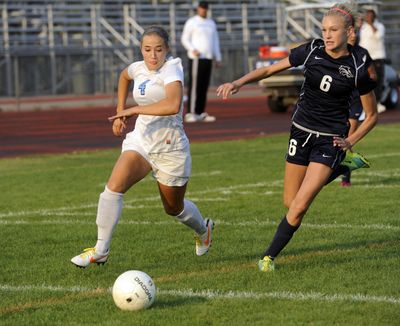Diabetes a game-changer
CV’s Casey, Grozdanich balance sports and disease

For a soccer player with diabetes, the game plays a little differently.
Your adrenaline flows, but not too much. You listen to coaches and teammates, but mostly to your body.
You push forward, then reluctantly pull yourself out of the game because you’re not feeling quite right.
That’s the tough part, said Erica Casey, one of two players on the Central Valley girls soccer team who live with Type 1 diabetes.
“It’s hard because when your blood sugar is low, you have to come out,” says Casey, 14, a freshman defender. “You want to keep playing, but then you have to come out and drink a juice.”
And stand on the sideline until your blood sugar level lets you back in the game.
More than 3 million Americans have Type 1, or juvenile, diabetes, which occurs when the body’s immune system destroys beta cells, which produce insulin, a hormone. Insulin moves the glucose (sugar) in food into the body, where it’s used as fuel. Without insulin, glucose stays in the blood, which if untreated can lead to coma and death.
Type 1 diabetics must take insulin just to survive. For a full life that includes varsity soccer, juggling a ball is the easy part, said teammate Sara Grozdanich.
“It’s hard to keep your blood sugar in check when you’re playing sports,” said Grozdanich, a 16-year-old junior who starts at forward.
“It’s healthy to do that when you have diabetes, but having adrenaline before games tends to raise your blood sugar, so you have to take a lot of insulin beforehand.”
But it has to be carefully self-managed during a match, or performance will suffer. In a Canadian study on athletes ages 9 to 17, researchers found that low blood sugar levels decreased basic sports skills an average of 20 percent.
After the game, blood sugar tends to drop. Symptoms include trembling, accelerated heart rate, sweating and hunger – all of which can be confused with non-diabetic reaction to exercise.
Still, athletes with Type 1 diabetes have succeeded, even thrived. Professional athletes with Type 1 diabetes include Chicago Bears quarterback Jay Cutler and former NBA center Chris Dudley. Former Gonzaga basketball star Adam Morrison helped Casey “understand that you can be a college athlete with diabetes.”
Being a diabetic teen may be even tougher. Grozdanich and Casey each wear an insulin pump, and self-test with a finger prick 10 to 12 times a day – balancing homework and a social life along with their blood-sugar level.
“Any types of nerves tend to raise my blood sugar,” Grozdanich said. “I’ve had to retake a few tests because of my blood sugar.
“You’ve just got to keep battling.”
It helps that others are fighting, too.
“My teammates are awesome, and they’re always asking me if I need anything,” Grozdanich said.
At night, mom Sue checks on her.
“She’s always there when I need something,” Grozdanich said.
On a larger scale, the Juvenile Diabetes Research Foundation will hold its annual Walk to Cure Diabetes on Sept. 23 at Riverfront Park.
Each girl has a team: Sara’s Supporters and Team Erica.
“It’s important to keep up funding,” Grozdanich said.
“It’s awesome to see your friends and family out there supporting and how many people who come out.”